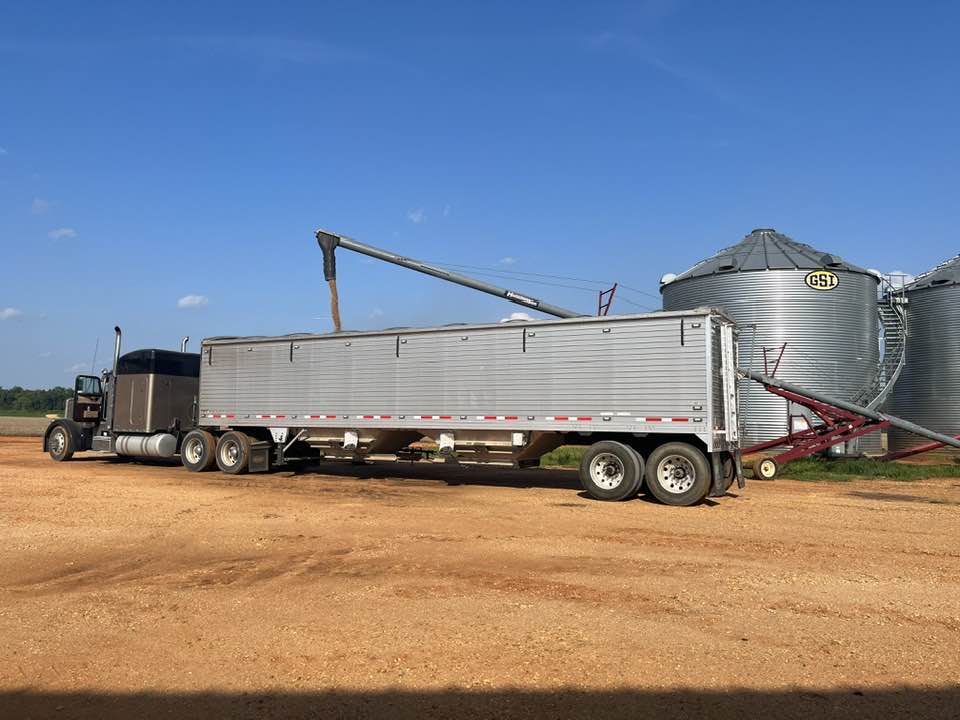Farmers Face Freight Frustration

By Marlee Jackson
As margins tighten across farm country, some Alabama producers face a frustrating line item — freight.
“Even when gas and diesel come back down, freight never goes in reverse,” said Dallas County farmer Wendy Yeager.
Wendy and her husband, Jamie, began farming in 2007. That year, they paid 40 cents per bushel for freight, or the cost to truck commodities to market. It’s now more than doubled to 95 cents per bushel.
“Truckers have bills to pay, too. We get it,” Wendy said. “As a producer, it’s very frustrating because our input costs across the board go up, but nothing comes back down.”
Diesel is a significant slice of freight costs. For the week ending May 27, U.S. diesel prices averaged $3.76 per gallon. That’s down 3.1 cents from the previous week and 9.7 cents below the same week last year, according to the U.S. Department of Agriculture (USDA) Agricultural Marketing Service.
Freight likely won’t follow, Wendy said.
If the Yeagers lock in corn for $5 per bushel on the market, nearly $1 freight adds up quickly. That’s 20 percent of their price off the top. It’s nearly $1,000 per truck, too, since semis shoot for 1,000 bushels each trip.
Freight eventually trickles down to consumers, albeit incrementally.
Take chicken.
Trucks transport seed to the farm, grain to mills, feed to the chicken farm, chickens to harvest facilities and protein to further processors — all before lean poultry arrives at the grocery store.
“There’s a lot of 18-wheelers involved in the process till food makes it to your plate,” Jamie said.
The Yeagers are realistic. The price they pay is partially due to Bell Place Farm’s location in central Alabama. Their Orrville farm is at least two hours away from major grain buyers in north Alabama and is removed from major poultry hubs.
Historically, central Alabama farmers have benefited from back-haul rates. Trucks would deliver soybean meal or other feedstuffs to the local catfish feed mill and offer reduced freight to haul raw commodities back north.
“We’ve tried to cut freight costs by using that system,” said Wendy, noting the difficulty in filling partial loads, too. “The problem is it’s harder to get back-haul rates these days.”

Alabama Farmers Federation’s Carla Hornady said consolidation constrains grain farmers. There’s just a handful of large-scale buyers for corn, wheat, soybeans and other feed commodities, mostly north of Birmingham.
“The miles you have to travel is going to affect your cost,” said Hornady, a commodity director who works with row crop farmers. “We’re restricted in Alabama on where farmers can take their raw commodities. If you’re traveling from central Alabama up Interstate 65, you’ve got to think about that long haul and possible backups on the interstate. Those backups directly affect your time and bottom line.”
Hornady said limited grain-buying facilities, coupled with last fall’s drought, could have impacted the state’s plunge in winter wheat. A spring report from USDA forecast Alabama wheat at just 134,000 acres, down 34% from last year.
Jamie said they’ve become more strategic marketers in the last decade. While traditional contracts are still an option, they’ve also worked with buyers who’ll purchase grain directly off the farm — and eat the cost of freight.
“It’s the little things that hopefully pay off in the end,” Wendy said.
